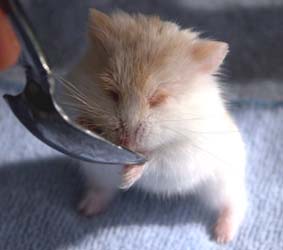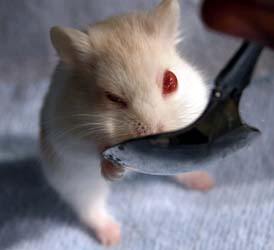Sputnik's and Kosmo's Glaucoma
by Miko Schmid
Sputnik was named in keeping with the theme of Russian dwarf hamsters. I also had the Spacestation cage, whose "tower" Sputnik kept "launching" (jumping) off of, so there we go! Kosmo was named for cosmonaut, but with the letter "K." I found out more recently that there was in fact a Russian Mars orbiter named Cosmos, so it worked out even better.
Sputnik and Kosmo got along great (just the occasional squabble) and what a thrill it was watching them interact and wheel together! Actually, I had two cages connected together, with a wheel in each cage. Sometimes they wheeled separately. Sometimes they traded sides - in perfect synchro like a circus act. When one hopped on the same wheel, the other jumped off, ran through the connector and hopped onto the other wheel - all without skipping a heartbeat. But the most hilarious of all was when they wheeled together; wonderfully smooth one moment, tossing each other the next!
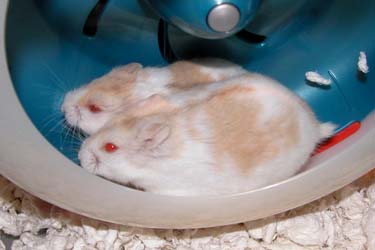
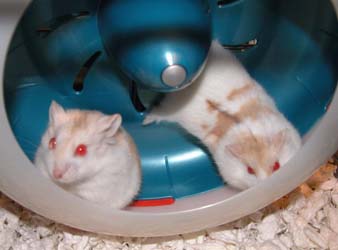
With each passing day of Sputnik's treatment, I hoped the bulging would go down. But I soon saw the medication did nothing for her eye. That confirmed it was probably glaucoma rather than an infection. In the meantime, Sputnik and Kosmo began fighting often and with more intensity. Previously, although Sputnik was the larger, dominant hamster, she was quite gentle and long-suffering with Kosmo, usually letting her have her way. But Sputnik was becoming less tolerant. Although they never came to bloodshed and after giving them adequate chances to become friendly again, it never improved, so I had to make the decision of splitting them. I was most concerned about the possibility of Sputnik's eye getting hurt in a squabble.
Having ruled out an infection, our next trip was to the animal eye specialist. He was a wonderfully kind man. He darkened the room, and with a lighted instrument, spent a long time looking into Sputnik's eye. He also had an instrument to touch to her eyes which I believe checks pressure in the eye. Do you remember those glaucoma eye tests where they surprise you with that big puff of air? I guess this instrument is the new way they check for high pressure. His diagnosis was that Sputnik had both glaucoma and a very rare congenital condition know as keratoconus, where the cornea of the eye is cone-shaped. He also confirmed what the vet had told us - that antiglaucoma medication would be more harmful than good and that surgery would be more risky than just leaving it alone. He differed from the vet though in that he was not happy with the type of antibiotic eyedrops we had received from that vet. It contained a steroidal component, and that was a no-no. He told us not to use those drops anymore.
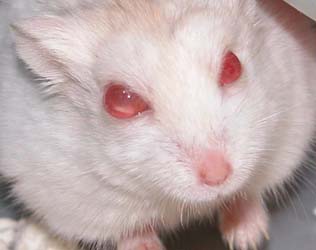
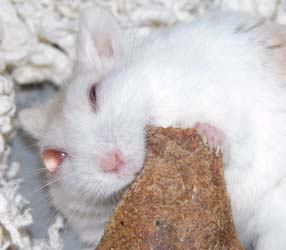
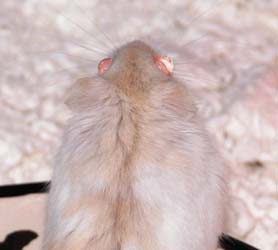
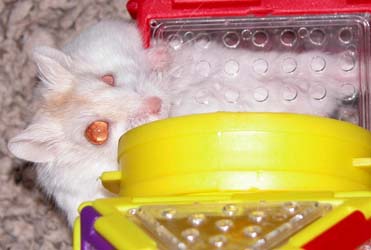
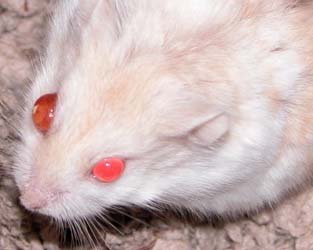
A long time passed and nothing more happened. When the next set of events occurred, we were surprised that it was Kosmo and not Sputnik, who had the eye problems. But knowing they were most likely sisters, it did reiterate the fact that this tends to be a genetically inherited disease. It was late August when I first noticed Kosmo's left eye bulging a little. Then through October and November, I observed a day that her troubled eye was especially bulgy and wet. Afterwards, she developed a "film" over that left eye. Throughout this episode, I applied lubricating ointment to her eye. This eye went through its "stages" without too much trouble and reached its final one - when the eye becomes small and "milky" looking. It looks like pinkish tea with cream in it. Or like an opaque, rose colored stone.
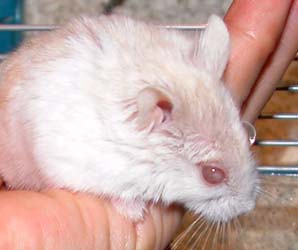
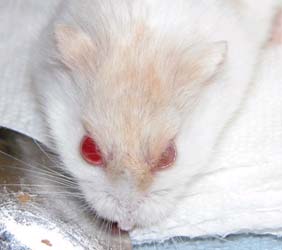
Our new animal eye doctor told us we had been doing all the right things - and to continue lubricating the eye with the ointment. She too concurred that antiglaucoma medication would cause significant systemic side effects. She said that Kosmo was a very playful hamster and that she was most likely fairly comfortable despite the somewhat disfiguring appearance of the eye. She also said that the bulging would subside and that it would become small, like the other eye was now.
Now if you knew how alarming a "popped" out eye looked, you would understand why my husband and I were rather disbelieving of what the doctor said; we could not imagine her eye becoming small again. But sure enough, Kosmo healed up quickly; within a week, her eye was smaller, and had developed a film over it. That soon turned into the final stage where the eye is opaque-looking and most likely blind. I've concluded that in the last stage, the hamster most likely cannot see. I deduced that because Kosmo now just keeps her eyes closed and I presume it's because she cannot see anyway.
For Sputnik, it wasn't until January of 2004, a long 7 months since first noticing her bulgy right eye, that it finally went through its next stages. First the dark, wine colored blood inside her eye, then a film developing over her eye, then finally, bleeding from the eye. A couple weeks later, the familiar opaque, "milky" eye. Currently, her left eye is at the bulging stage, sometimes alarmingly so - that I think any minute it will "pop" out or bleed. But strangely, with her, the initial bulging symptoms have lasted long without much happening for some time. I am prepared though when it does. I've already undergone the experience with three of their eyes - I KNOW right along with that fourth eye, Sputnik will bravely pull through! In my opinion, this disease is not terminal. Barring any other disease or disaster, I thankfully expect both of them to enjoy a regular lifespan.
Some people will think of their closed, blind eyes as a cosmetic defect. Not me. It represents to me a kiss of mercy. The closed eye no longer needs to suffer the stages that at the very least must be uncomfortable for the hamster. For the owner, those active stages are heartbreaking, creating a feeling of stark helplessness and panic.
Out of the senses hamsters can go without, sightlessness isn't so bad for a hamster. I've made the observation that in a familiar situation, they depend surprising a lot on spatial memory. I now know why, when they first go into a new or fresh cage, they go slower, sniffing everything out and doing the once around! When the hamster is placed in that cage again, my observation is that they know where everything is. I've seen this theory proven by the fact that a blind hamster will run into something if you place it in there AFTER they've already cased the place out. Sometimes they'll even bump into my hand if they haven't got a whiff or heard a sound first. But if nothing has been changed in their cage, they surprisingly get around easily without bumping into anything, even while running.
There are times I just sit quietly and watch Sputnik and Kosmo without them knowing I am there. With Kosmo (the completely blind one), when I decide to finally pick her up, I lean my face forward near her cage and let out a gentle, gentle breath. She stops what she's doing, her body stock-still, only her head turning and craning; her nose up, sniffing the air. I then speak and make the cage opening noise. Excitedly, she runs up the bars and climbs onto my awaiting hand.
